25 smart snacks to help you stay on track
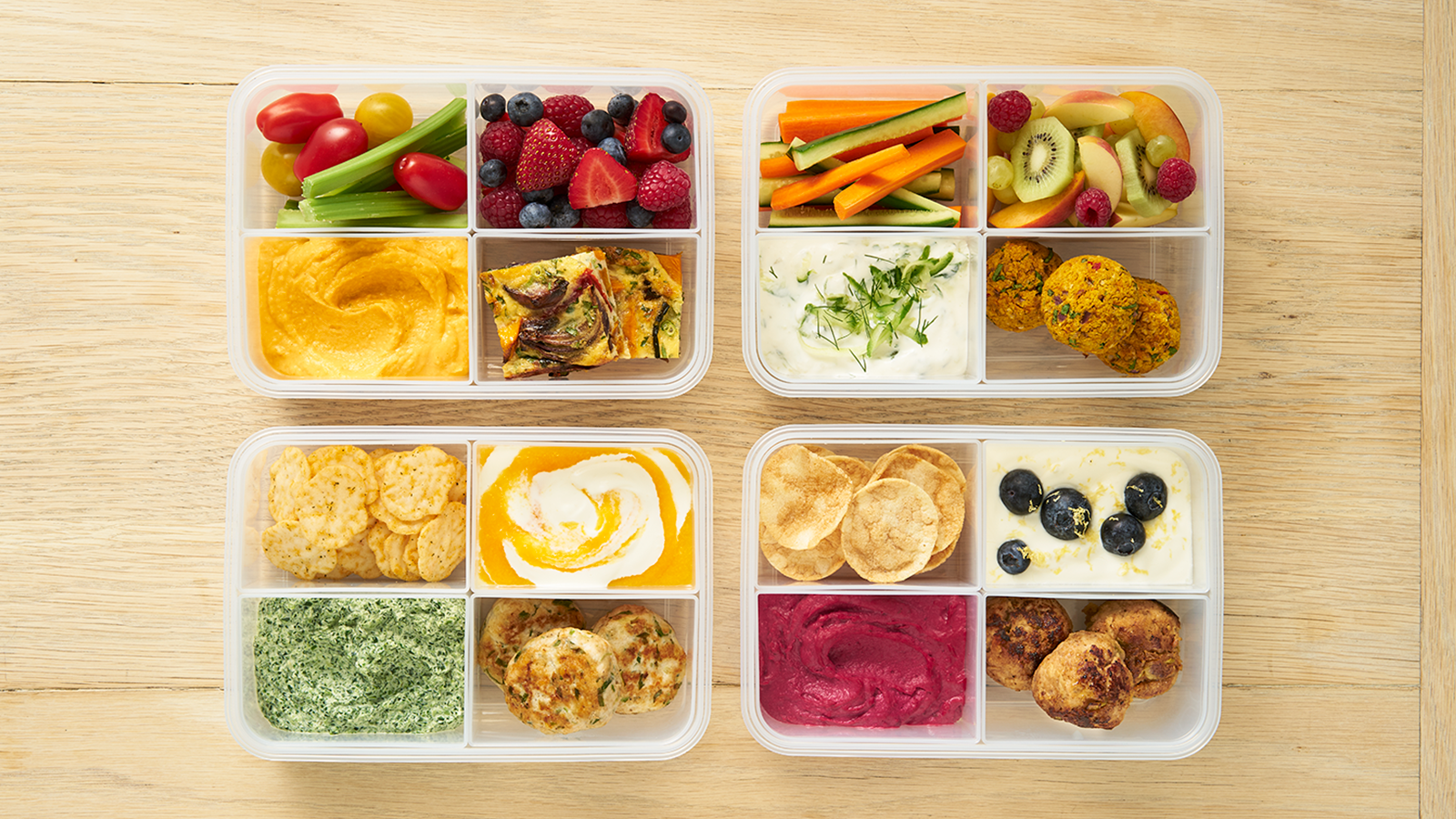

How healthier snacks may promote weight loss
Snacks may help you reach your weight-loss goals because they can:
- Reduce the chance of overeating: Because snacking between meals fends off hunger, it may help reduce the possibility of overeating at your next meal—particularly when you pair ingredients that are high in protein and fibre, according to a 2016 review of studies on snacking published in the journal Advances in Nutrition. Jaclyn London, a registered dietitian, also advocates adding fat to the mix.
- Diminish the desire to eat sweets: If you tend to reach for something high in sugar when you feel hungry, pairing high-fibre and high-protein foods can potentially help alleviate that urge. Fibre helps to slow the rate of digestion and absorption in your gastrointestinal tract, London says, while protein requires more "work" to break down and digests at a slower rate. It’s one reason why pairing an apple (for its fibre) and cheese (which serves up protein) may help you feel fuller for longer.
- Provide nutrients: Your body needs both macronutrients (i.e., fat, protein, and carbohydrates) and micronutrients (vitamins and minerals) to function. But as it happens, consuming nutrient-dense foods can also help you lose weight in the long run: In a 20-year study of 120,000 adults conducted by the Department of Nutrition at Harvard School of Public Health, researchers found that people who ate a diet rich in fruits, vegetables, yoghurt, nuts, and wholegrains rather than lower nutrient dense foods (i.e., potato chips, sugar-sweetened beverages, and processed meats) were more apt to lose weight than gain it over the course of two decades.
For some healthier snacks that can support weight loss (and actually taste good), read on:
Go savoury: 8 healthy snack ideas
Remember: You want your savoury snack to contain protein, fibre, and healthy fats. “I typically recommend combos that combine produce, wholegrains, starchy veggies, satisfying protein, and fat-containing additions like nuts and nut butter, seeds, spreads—like hummus and tahini—hard boiled eggs, or cheese,” London says. Alternatives may include:
1. Edamame
If you’re looking for a simple snack that packs a nutritional punch, edamame beans are a great choice: A half-cup serving of edamame contains a source of protein and fibre, as well as calcium, which many adults don’t get enough of. You can find green soy beans, which either come in pods or de-shelled, in most grocery shops in the frozen vegetable section. Just microwave a serving (about half a cup of shelled beans or a heaped cup of beans in their pods) and sprinkle it with a bit of sea salt to enjoy.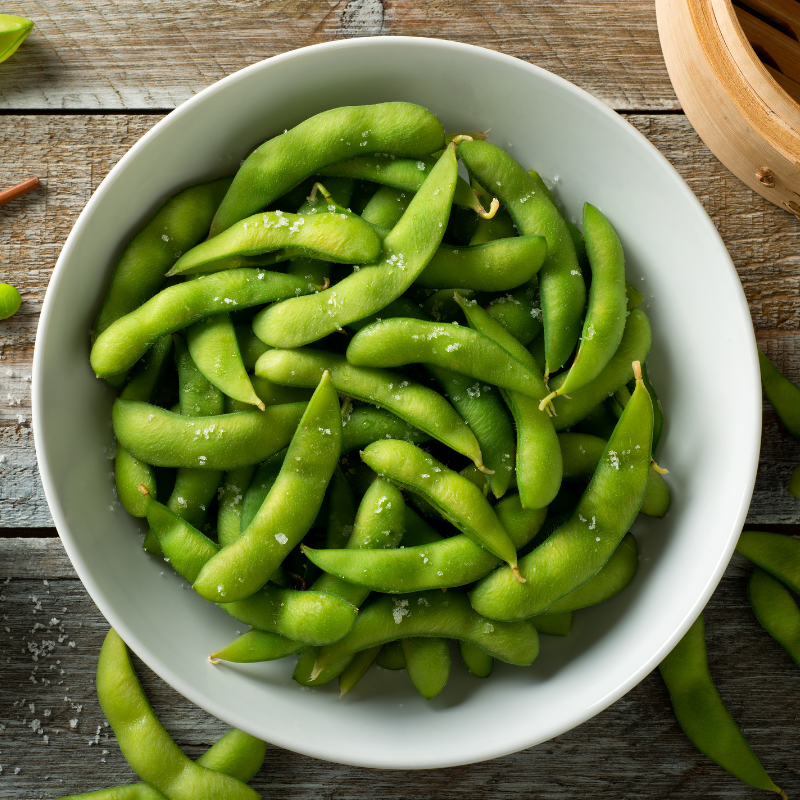
2. Caprese bites
The elements of a Caprese salad deliver vitamins C and A (from the tomatoes), fat and protein (thanks to low-fat or fat-free mozzarella cheese), plus a burst of flavour (thank you, basil!). Thread these ingredients on a toothpick or stack them on a bite-sized piece of bread for portability.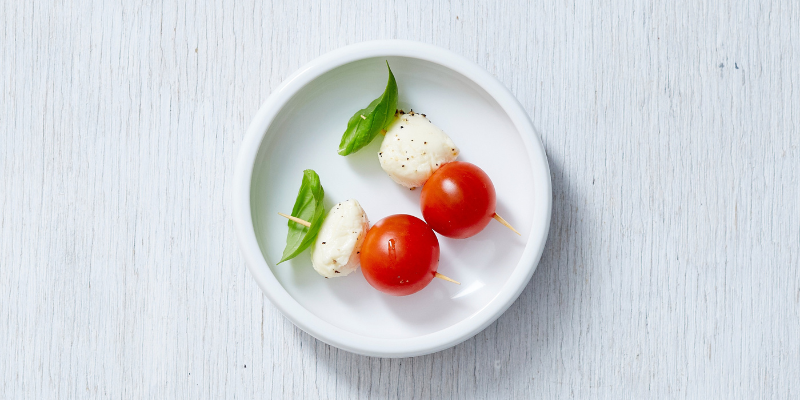
3. Hummus and carrot
Often find yourself reaching for crunchy snacks? Try baby carrots. Easy to pack in a reusable storage container on the go, they’re rich in fibre, as well as vitamins C and A. Just add hummus: Made from smashed chickpeas with spices, oil, and tahini, this dip is a great source of protein, fibre, and healthy fats.
4. Parmesan popcorn with lemon and thyme
Instead of buying pre-packaged popcorn, which can sometimes deliver a long list of unnecessary ingredients, pop your own on the stove or in the microwave and add a sprinkle of parmesan cheese and dried thyme. This particular recipe not only contains fibre from popcorn, London says, but protein from parmesan, a higher protein cheese. Popcorn is also a ZeroPoint food meaning you don't need to track it.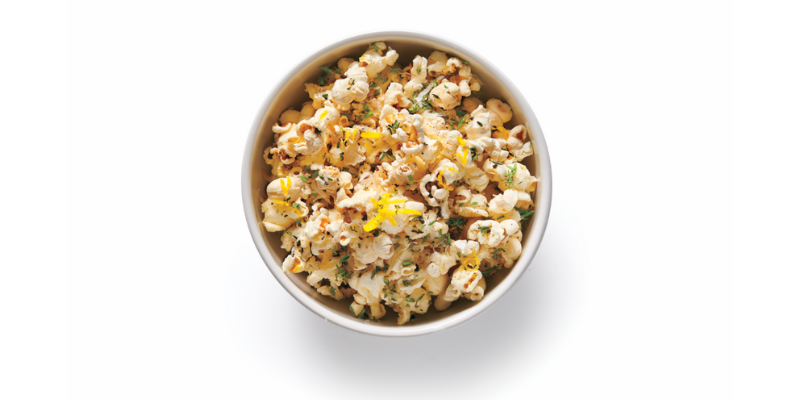
5. Rosemary sweet potato oven fries
Wedges of sweet potatoes (which provide fibre, protein, and complex carbs) make excellent oven-baked fries. Try them in our rosemary sweet potato chips recipe.
6. Swiss cheese and grapes
In a hurry and need something that requires zero prep? Grab a cup of grapes to load up on fibre and vitamin C, and about 30 grams of cubed, low-fat Swiss cheese, which contains satiating protein and calcium.
7. Prawn and cucumber tzatziki bite
Prawns deliver a dose of protein without a lot of fat—and the same goes for 99% fat-free Greek yoghurt. Combine these protein powerhouses with raw cucumber, lemon juice, and herbs like mint and dill, and you’ve got a light snack that’s sure to wake up those taste buds.
8. Zucchini sticks with honey-mustard mayo
Zucchini is a nutrient-dense veggie that serves up fibre and complex carbs. When coated in breadcrumbs and baked, zucchini sticks taste similar to fries. To add fat to the mix, try homemade honey-mustard mayo for dipping.
7 healthier sweet snack ideas
If you feel like something sweet after lunch, have it! “The more we try to ‘save up’ or limit ourselves throughout the day, the more likely we are to overindulge later on,” London says. Instead of avoiding sweets, hit the spot with a snack that also contains protein, fat, and fibre.
1. Chocolate-drizzled strawberries
Fruit can hit the sweet spot due to its natural sugar content. Drizzle strawberries in dark chocolate, which typically contains less added sugar than milk chocolate, and also contains flavonoids, antioxidants that have been linked to a lowered risk of heart disease. Set in the fridge until firm, then enjoy. (If you’re looking to amp up the protein and lower the sugar content of this snack, London recommends skipping the dark chocolate and spreading unsweetened peanut butter on your fruit instead.)
2. Greek yoghurt and mixed berries
Convenient and affordable, yoghurt has calcium, protein, magnesium, and B12 content. What’s more, most yoghurts contain gut-friendly probiotics, which may help promote digestion. Greek yoghurt, which is strained, tends to be thicker, creamier, and have a higher concentration of protein than traditional yoghurts. To sweeten the deal, add berries, which deliver fibre, vitamin C, and folate along with natural sugars, and a drizzle of honey and walnuts for some dietary fat and a heartier snack. 99% fat-free plain Greek yoghurt is also a ZeroPoint food, making it a great go-to option.
3. Frozen yoghurt-covered blueberries
Coat high-fibre, vitamin C-rich blueberries in protein-rich 99% fat-free plain Greek yoghurt, then freeze them on a flat surface. For something even sweeter, try the blueberry cheesecake-yoghurt bark pictured below.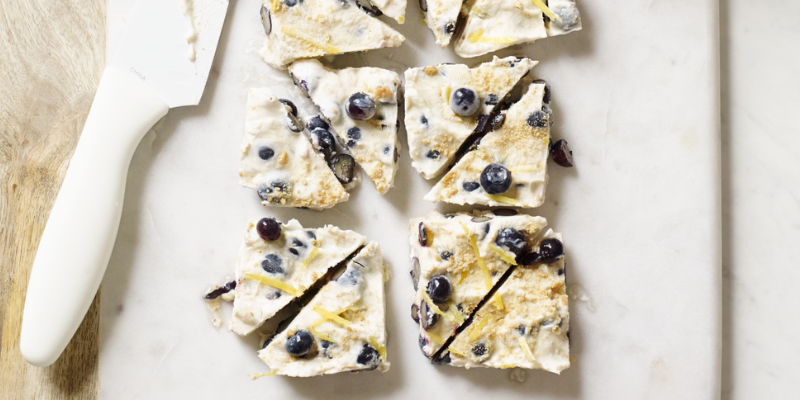
4. Dark-chocolate-covered almonds
Almonds make a well-rounded snack choice as they’re high in fibre, magnesium, calcium, and healthy fats. What’s more, a few small studies—including one published in 2013 and one in 2014—suggest snacking on almonds may promote satiety.
To step this snack up a notch, reach for dark-chocolate-covered almonds, which are found in most grocery stores. (Tip: Look for brands without added sugars or a long list of artificial ingredients.) You can also make your own by dipping almonds into dark chocolate and letting them harden.
5. Strawberry basil ice blocks
Blend naturally-sweet strawberries, which are rich in fibre and vitamin C, with a bit of honey and fresh lemon and freeze in a popsicle mould for a snack that sure feels like dessert. For a boost of protein, London recommends adding a serving of cottage cheese to the mix before freezing.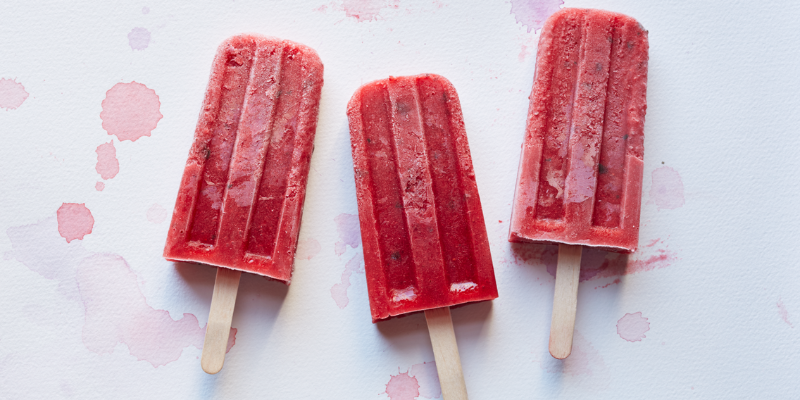
6. Apple slices with chocolate and peanut butter
Another source of fibre and vitamin C, apples are the perfect grab-and-go snack. To add a dose of protein and satiating healthy fats, slice one up and top with peanut butter, then drizzle with chocolate syrup. Pro tip: When prepping an apple-based snack you’ll eat later, prevent browning with a squeeze of fresh lemon juice.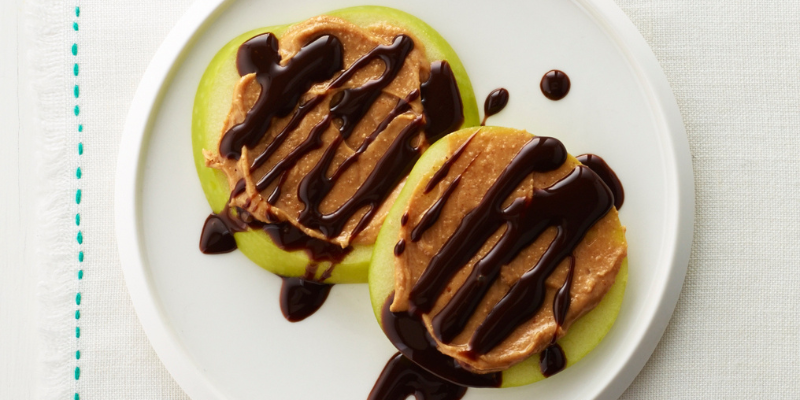
7. Maple-pecan fried bananas
Bananas are full of fibre as well as potassium, an essential mineral that helps support healthy blood pressure. Another pro: They’re naturally sweet. Fry and top with protein-rich pecans.
Healthier snack ideas for work
While there’s nothing wrong with enjoying the occasional office doughnut, having a few healthier go-to options can prevent you from overindulging. Try these:
- Seeds
- Raw nuts
- Dried fruit
- Wholegrain crackers
- Bliss balls
- Whole fruit
- Baked kale chips
- Wasabi peas
- Freeze-dried fruit
- 99% fat-free plain Greek yoghurt
- Low-fat cheese sticks
- Hard-boiled eggs
- Bran muffins
Tips for buying healthier snacks
When it comes to filling your fridge, pantry, and snack boxes with healthier packaged snacks, there’s no shortage of options; however, some healthy-sounding processed foods can contain added sugars and salt, two additives many people already consume in excess. The best way to ensure that you’re choosing foods that will actually benefit your body is to do a little planning:
- Make a list. Instead of grabbing items that look good to you in the moment, plan which snacks you want to eat before heading to the shops.
- Shop all the aisles. Since the basis of many healthy snacks tends to be produce, begin with the shop’s perimeter, where fruits and vegetables tend to be sold. Then top off your trolley as you'd top off your snack: Add canned goods like beans and soups, wholegrain crackers, peanut butter, and so on.
- Check the ingredients. When you’re considering whether to purchase pre-packaged food, check the first few ingredients for added sugars, which may be listed as maltose, brown sugar, corn syrup, cane sugar, honey and fruit juice concentrate. Another ingredient to watch-out for is sodium, which could lead to high blood pressure and related issues if consumed in excess regularly. Packaged goods with phrases like, “no salt added,” “low-sodium,” or “reduced-sodium” tend to be safer bets.
- Choose single-serve packages. Knowing how much food is in a portion can help you avoid eating more than you think you are. Single-serve packages eliminate any guesswork. Bonus: They also make snacking on-the-go super convenient.
- Splurge on flavours, not calories (kilojoules). Keep your taste buds from growing weary by trying new flavours and spices whenever possible. If you love eating veggies with hummus, try the roasted garlic tub one week and beetroot hummus alternative the next. Top your Greek yoghurt with berries one week, and then try homemade granola the next.
The upshot: Can healthy snacks help you reach your goals?
A healthy snack nourishes your body, satisfies you between meals, and tastes delicious. “The more satisfied we physically feel, the simpler it becomes to stay in touch with hunger and satiety cues,” London says.
What's more, getting creative with flavours, and cycling through a wide variety of whole foods to get those macro and micronutrients, can help save both your body and your taste buds from fatigue.
